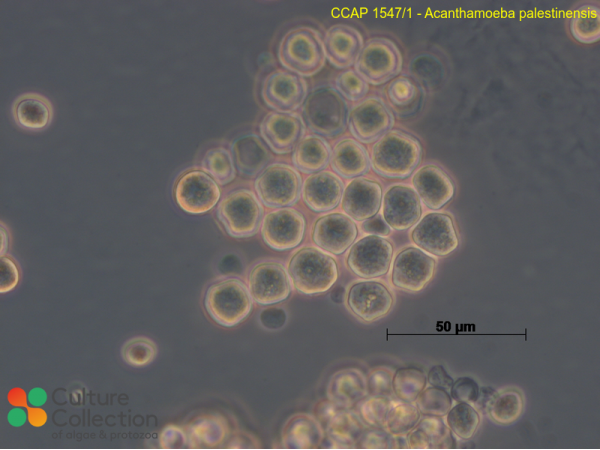References [ 15 ]
Kassab K, Dei D, Roncucci G, Jori G & Coppellotti O (2003) Phthalocyanine-photosensitized inactivation of a pathogenic protozoan, Acanthamoeba palestinensis. Photochemical & Photobiological Sciences 2: 668-672.
Costas M & Griffiths AJ (1984) The esterases and acid-phosphatases of Acanthamoeba (Amoebida, Acanthamoebidae). Protistologica 20(1): 33-41.
DOI: none
Costas M & Griffiths AJ (1984) Taxonomic significance of the fatty acid composition of Acanthamoeba (Amoebida, Acanthamoebidae). Protistologica 20(1): 27-31.
DOI: none
Daggett PM, Sawyer T & Nerad T (1982) Distribution and possible interrelationships of pathogenic and nonpathogenic Acanthamoeba from aquatic environments. Microbial Ecology 8(4): 371-386.
Lorenzo-Morales J, Ortega-Rivas A, Martínez E, Khoubbane M, Artigas P, Periago MV, Foronda P, Abreu-Acosta N, Valladares B & Mas-Coma S (2006) Acanthamoeba isolates belonging to T1, T2, T3, T4 and T7 genotypes from environmental samples in the Nile Delta region, Egypt. Acta Tropica 100: 63-69.
Dudley R, Matin A, Alsam S, Sissons J, Maghsood AH & Khan NA (2005) Acanthamoeba isolates belonging to T1, T2, T3, T4 but not T7 encyst in response to increased osmolarity and cysts do not bind to human corneal epithelial cells. Acta Tropica 95: 100-108.
Wright SJL, Redhead K & Maudsley H (1981) Acanthamoeba castellanii, a predator of cyanobacteria. Journal of General Microbiology 125: 293-300.
Khan NA, Jarroll EL, Panjwani N, Cao Z & Paget TA (2000) Proteases as markers for differentiation of pathogenic and nonpathogenic species of Acanthamoeba. Journal of Clinical Microbiology 38: 2858-2861.
DOI: none
Hughes R, Andrew PW & Kilvington S (2003) Enhanced killing of Acanthamoeba cysts with a plant peroxidase-hydrogen peroxide-halide antimicrobial system. Applied and Environmental Microbiology 69: 2563-2567.
De Jonckheere JF (1980) Growth characteristics, cytopathic effect in cell culture, and virulence in mice of 36 type strains belonging to 19 different Acanthamoeba spp. Applied and Environmental Microbiology 39: 681-685.
DOI: none
Baquero RA, Reyes-Batlle M, Nicola GG, Martín-Navarro CM, López-Arencibia A, Esteban JG, Valladares B, Martínez-Carretero E, Pinero JE & Lorenzo-Morales J (2014) Presence of potentially pathogenic free-living amoebae strains from well water samples in Guinea-Bissau. Pathogens and Global Health 108: 206-211.
Chelkha N, Jardot P, Moussaoui I, Levasseur A, La Scola B & Colson P (2020) Core gene-based molecular detection and identification of Acanthamoeba species. Scientific Reports 10: 1583.
Fuerst, PA (2023) The status of molecular analyses of isolates of Acanthamoeba maintained by international culture collections. Microorganisms 11(2): 295.
Fuerst PA & Booton GC (2020) Species, sequence types and alleles: Dissecting genetic variation in Acanthamoeba Pathogens 9(7): 534.
Corsaro D, Walochnik J, Köhsler M & Rott MB (2015) Acanthamoeba misidentification and multiple labels: redefining genotypes T16, T19, and T20 and proposal for Acanthamoeba micheli sp. nov. (genotype T19) Parasitology Research 114(7): -.









